
Uncharted: Golden Abyss review
After 3 iterations from Naughty Dog, Uncharted has become a flagship Playstation franchise. Many people even consider it synonymous with cinematic video games, for better or worse. I haven’t played any game in the console series, but if I had to estimate their collective quality based on the Vita exclusive Uncharted: Golden Abyss, developed by a different studio, I would never play any of them. Golden Abyss is absolutely plagued with problems, none of which particularly game-breaking, but the huge abundance of issues kills the experience.
Let’s start with the main menu, for example. You can’t use the physical controls to navigate menus, limiting you to the touch screen. That would be fine if it were well optimized. Rather than just selecting a menu item on the screen, you have to slide it to the center, then select it. I know I’m nitpicking, but the point I’m trying to make is that it’s pretty foreboding that I hadn’t reached any actual gameplay before encountering stupid design choices.
You play as Nathan Drake, a treasure hunting explorer who happens to be hunting treasure with his antagonistic buddy, Dante, before meeting up with another treasure hunter, Marisa. Honestly, I personally don’t care enough about the story to describe it here in detail. Just read the first three paragraphs in the Plot section of the game’s Wikipedia page if you care that much. I’ll admit that the story does flow pretty smoothly, even if some cutscenes go on too long, but the story isn’t my concern. For this review, I want to focus purely on the gameplay.
Half of which being exploration, which is ironic considering how strictly linear it is. It’s impossible not to know which way you’re supposed to be going, which I guess is a good thing, but it leaves very little challenge. Seriously, exploring in Golden Abyss feels completely unnecessary. When you’re not running down a path, you’re climbing around on scenery, which would be cool if it wasn’t so straightforward. There’s a yellow glow on virtually everything you can climb on, as if the game didn’t want you to actually figure something out. They even included the ability to touch the screen along the path of yellow glows to automatically climb them. You know something’s messed up when they make something as basic as following a path automatic. Before you know it, all video games will just beat themselves for you.
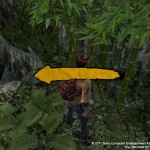 Golden Abyss makes use of many of the Vita’s hardware features, not the least of which being motion control. For example, when climbing, you can tilt the Vita in the direction you want to jump, provided you’re in a position to do so. Problem is, say you’re playing while laying on your right side, because God forbid you want to be comfortable playing a handheld game, and you want to jump to the left. Even if you’re holding the analog stick to the left, you need to reorient the console to a neutral position to be able to jump, because the game thinks you want to jump to the right, whether or not it’s possible to do so. I thought the controls were broken until I tried to recreate it on camera, when I realized it was motion based. There’s no option to turn it off.
Golden Abyss makes use of many of the Vita’s hardware features, not the least of which being motion control. For example, when climbing, you can tilt the Vita in the direction you want to jump, provided you’re in a position to do so. Problem is, say you’re playing while laying on your right side, because God forbid you want to be comfortable playing a handheld game, and you want to jump to the left. Even if you’re holding the analog stick to the left, you need to reorient the console to a neutral position to be able to jump, because the game thinks you want to jump to the right, whether or not it’s possible to do so. I thought the controls were broken until I tried to recreate it on camera, when I realized it was motion based. There’s no option to turn it off.
When you’re not exploring, you’re either solving puzzles or engaged in combat. Actually, “solving” isn’t really an accurate word, more like “doing” puzzles, since they never require any thought. These puzzles frequently make use of one or both of the Vita’s touch sensitive panels. Sometimes you’re cleaning dirt off an object with the touch screen. You’re supposed to feel like you’re swiping the dirt away, but it just makes your finger feel like a vacuum cleaner. Other times you’re piecing together a torn parchment, like a poster or a map, which isn’t challenging in the slightest. Most annoying are the regularly encountered coal rubbing segments that involve simply rubbing the touch screen until you’ve rubbed every part of the paper. It’s really picky about how much of the picture you’ve uncovered – you could have it 99% uncovered with only a sliver missing, but it can be hard to find where that missing sliver is. Is Nathan Drake that much of a perfectionist that he refuses to return to his duties unless every last corner of the picture is complete?
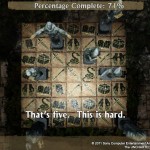 The only puzzles that are even close to being real puzzles are counter-intuitive due to comments from Marisa. The example that sticks in my mind involves placing six unique statues on a 6-by-6 grid, and you have to figure out where each statue goes based on clues. I was so excited to be solving a legitimate puzzle, until Marisa confirmed the first statue I placed was correct, continuing to confirm each statue as you place them correctly. She even tells you when you move a statue that used to be correct. Being condescending towards the player is one thing, but flat-out ruining the puzzle is unacceptable.
The only puzzles that are even close to being real puzzles are counter-intuitive due to comments from Marisa. The example that sticks in my mind involves placing six unique statues on a 6-by-6 grid, and you have to figure out where each statue goes based on clues. I was so excited to be solving a legitimate puzzle, until Marisa confirmed the first statue I placed was correct, continuing to confirm each statue as you place them correctly. She even tells you when you move a statue that used to be correct. Being condescending towards the player is one thing, but flat-out ruining the puzzle is unacceptable.
I think I should take a little intermission from all this negativity and talk about something good: the graphics. At the unfortunate expense of being a lower-res picture upscaled to the Vita’s resolution, I was consistently impressed by Golden Abyss’ visuals. When Sony was touting console-quality graphics on a handheld, this was often the game they spotlighted. The graphics aren’t quite console-quality, but pretty close. Water effects, lighting, shading, and especially texture quality, which is often fairly muddy on other Vita games, all look good for handheld graphics. Although the rendered graphics are upscaled, the HUD remains native, so it feels kind of mismatched overlayed onto the main game. Golden Abyss was so visually appealing, that the graphics alone were the only thing keeping me playing.
Finally, we get to combat. I said earlier you would be “engaged” in it, but that also seemed to be the wrong word to use. Golden Abyss’s combat is that of a painfully simplistic third-person cover based shooter. The variety of guns you can use is shallow, and the AI of your enemies even shallower. You’ll probably never run out of ammo, either, seeing as how guns are often conveniently located near combat areas, most notably sniper rifles. Speaking of which, here’s a pro tip: use the sniper rifle. It kills in one hit, no matter where you hit your enemy. They even injected motion controls into combat – just tilt the Vita to aim around. It doesn’t work great on its own, but to the game’s credit, it works pretty well in conjunction with the right stick. Aiming with the right stick alone feels a bit jerky, which makes me think they intentionally botched the stick aiming to make motion aiming more viable.
Sprinkled all over the game are quick-time events, the bane of my existence. There are sections where you hack down plants or tarps by swiping the touch screen in a few directions, but your character doesn’t follow your actions right away. Instead, he’ll hack away only after you’ve finished, distancing the player from any immersion factor there may have been. Periodically, you’ll need to give your partner a boost up to a higher platform. In these cases, get used to swiping up on the screen, because you’ll be doing this often. These QTEs may be my biggest gripe with the game. In fact, spoiler alert: even the final boss is a QTE. I was about ready to commit suicide to save myself the torture of another damn quick-time event.
Ultimately, Golden Abyss suffers from being far too rudimentary. Sure, it makes use of all the Vita’s control elements, but it doesn’t do it very creatively. Strip away these features, and you’re left with an exhaustingly simplistic action-adventure game. Sadly, this game could be easily recommended to people who wish to get into gaming, so while I commend it for being accessible, it fails to provide experienced gamers with any satisfaction or challenge whatsoever.
2 out of 5
Categories: Reviews
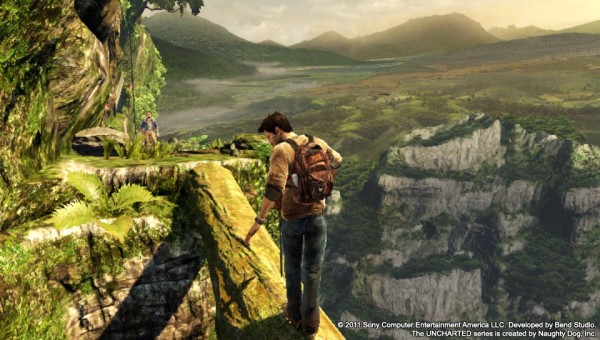
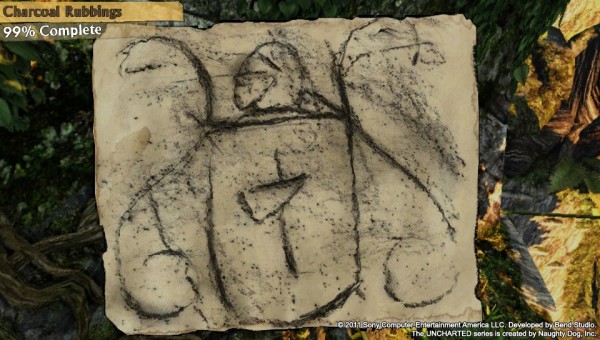
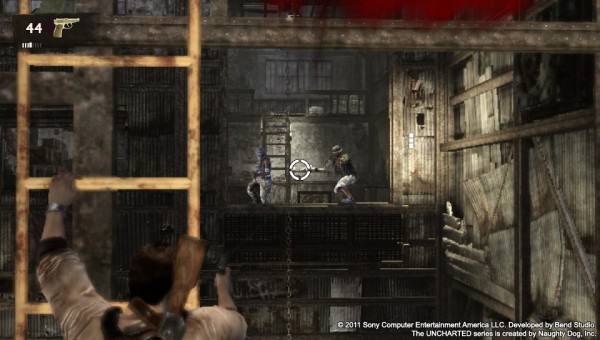
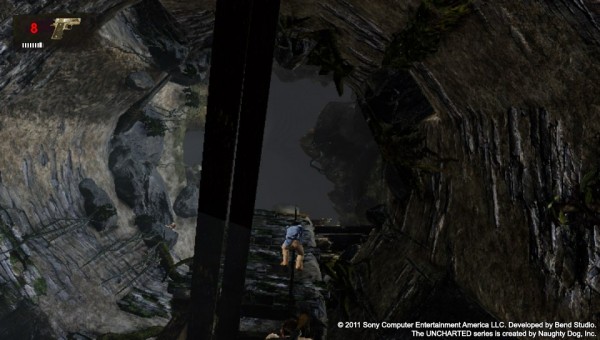
0 Comments
This post has been left all alone with no comments. Don't leave it lonesome - give it some company with a comment.